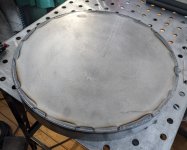jellywerker
Plastic
- Joined
- Mar 26, 2016
I'm working on a project with a number of steel discs that need to be banded with a rolled frame, and then seam welded on the exterior so they can be ground down for a cosmetic finish. All materials are 1/8in mild steel. The band is flush with the disc on one side. Think of a round tray.
I am finding that despite taking efforts to limit heat input, by the time I've seam welded the entire circle, the contraction from the welds cooling is enough to force the base plate to deform/oil can - about 1/8in over 20in.
I am stitch welding the seam, about 2in at a time and rotating to the opposite side. 70-80 amps DC tig, minimal filler. Edges are prepped with only a tiny bevel, as it's purely cosmetic and I don't want to put too much metal in.
Any thoughts on mitigating this? Would peening out the weld be helping? I'd be happy to torch it back hot and hammer around.
I am finding that despite taking efforts to limit heat input, by the time I've seam welded the entire circle, the contraction from the welds cooling is enough to force the base plate to deform/oil can - about 1/8in over 20in.
I am stitch welding the seam, about 2in at a time and rotating to the opposite side. 70-80 amps DC tig, minimal filler. Edges are prepped with only a tiny bevel, as it's purely cosmetic and I don't want to put too much metal in.
Any thoughts on mitigating this? Would peening out the weld be helping? I'd be happy to torch it back hot and hammer around.


